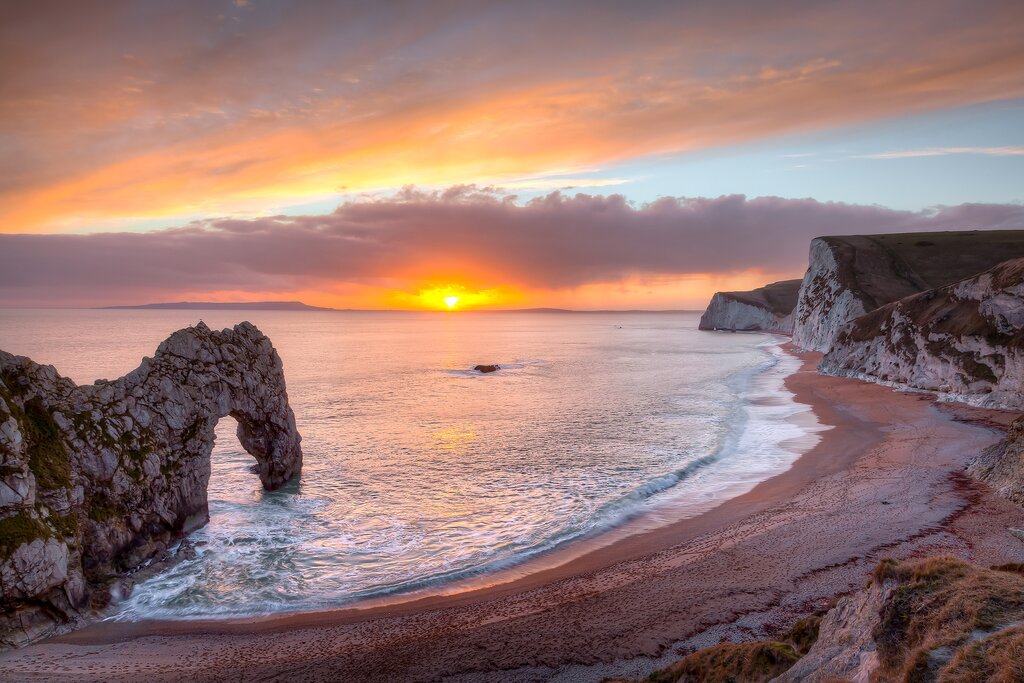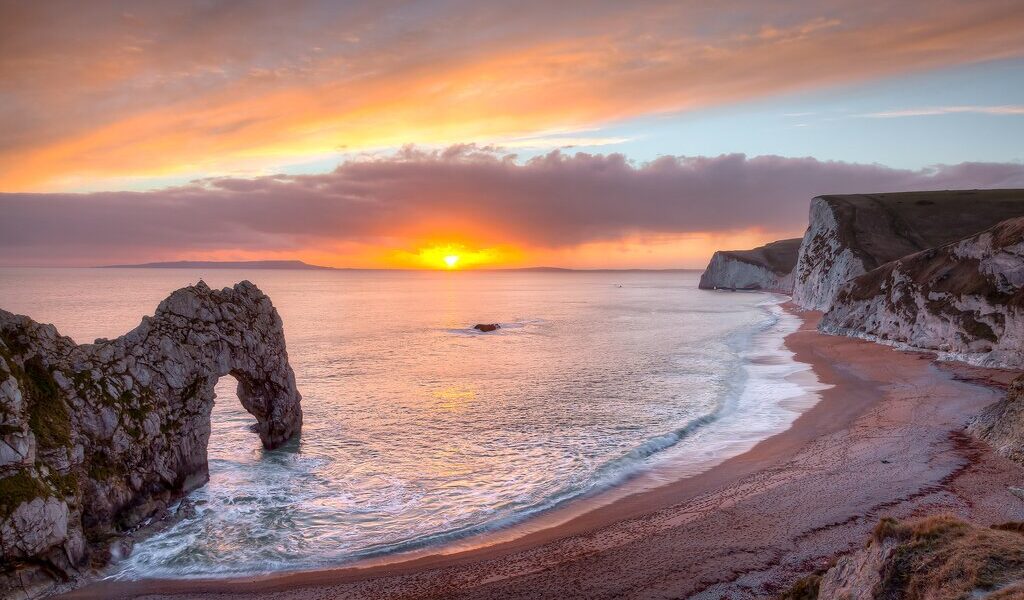
March signifies a hopeful transition toward spring. This is when temperatures and daylight hours are on the upswing, while rates remain low (except for Easter if it falls early). Use this month to take advantage of less-crowded cultural opportunities and scenery, perhaps with a coastal hike in the south where there may be more sunshine and milder temperatures.
Weather in England During March
England’s climate, known for its moderate nature throughout the year, experiences a subtle but noticeable shift in March as it transitions from winter to spring. While not a dramatic change, the temperatures begin to rise incrementally, offering a welcome respite from the chill of the preceding months. The air feels less heavy and the atmosphere brighter, signaling the arrival of a new season. In London, the nation’s bustling capital, average temperatures in March typically reach daily highs of 54°F (12°C), providing a comfortable climate for exploring the city’s many attractions. The evenings, however, can still be cool, with lows hovering around 43°F (6°C), so it’s essential to pack accordingly. Venturing further north, to cities like Leeds and Newcastle, which are situated closer to the Scottish border, expect temperatures to be a few degrees cooler than those in the capital. This difference is due to their geographical location and exposure to northerly winds. Conversely, the southwest tip of England, particularly in Cornwall, will likely experience milder conditions compared to the rest of the country. This is largely attributed to the influence of the Gulf Stream, a warm ocean current that moderates the region’s climate, making it a desirable destination for those seeking an early taste of spring.
While March sees a decrease in rainfall compared to other times of the year, the English weather remains notoriously unpredictable. It’s crucial to be prepared for a variety of conditions during your visit, including sunshine, clouds, and the occasional shower. Packing layers is essential to adapt to fluctuating temperatures throughout the day. A warm coat that can withstand moisture is also highly recommended, as is an umbrella, ensuring you’re protected from any unexpected downpours. The good news is that daylight hours are increasing steadily throughout March, with close to 13 hours of daylight by the end of the month. Furthermore, the clocks move forward an hour towards the end of March, marking the start of British Summer Time and providing even longer evenings—a definite sign of spring’s arrival and perfect for extending your sightseeing adventures.
Crowds and Costs in March
The period between winter and spring in England is generally considered the off-season, which translates to fewer crowds and a more relaxed atmosphere for travelers. This is an ideal time to take advantage of off-peak pricing for various travel expenses, including flights, accommodations, car rentals, and activities. However, it’s worth noting that prices and crowd levels may increase towards the end of March if Easter week falls early in the year. This is particularly true in popular destinations like London, where you might encounter an influx of spring break crowds eager to enjoy the city’s attractions. If you prioritize having more space and fewer people around at the popular sights, the first half of March is undoubtedly the best time to visit. You’ll have a greater opportunity to explore at your own pace and fully appreciate the cultural and historical landmarks without feeling rushed or overwhelmed. The reduced crowds also make it easier to secure reservations at restaurants and other popular venues.
Where to Go in England
London, a global hub of culture, finance, and innovation, remains a must-visit destination for travelers to England. As the gateway to the country for many, thanks to its largest airport, Heathrow, London offers a wealth of experiences to suit every interest. A trip to England is hardly complete without spending at least a few days in “The Big Smoke,” regardless of how many times you’ve visited before. With its ever-evolving landscape of art, entertainment, dining, and historical sites, there’s always something new and exciting to discover in London. From world-class museums and art galleries to iconic landmarks and vibrant neighborhoods, London captivates and inspires visitors from around the globe.
Beyond the capital, England boasts a plethora of distinct and charming cities that offer a glimpse into the country’s diverse cultural heritage. Cities like Manchester, renowned for its superb art galleries and impressive sports arenas, provide a vibrant and engaging atmosphere. Liverpool, the birthplace of the Beatles, offers a rich musical history and a thriving arts scene. The walled city of York, famous for its well-preserved medieval architecture, transports visitors back in time. These cities can easily fill a few days or more with exploration and discovery, and they often offer more affordable prices compared to London. For those looking for a convenient day trip from London, cities like Bath, known for its Roman-era baths and elegant Georgian architecture, or Birmingham, a major industrial and cultural center, are easily accessible by train in approximately 90 minutes. Similarly, the beautiful college campuses of Oxford, with their stunning architecture dating back to the 12th century, provide a captivating glimpse into England’s academic history.
If you have more time to spare and value the freedom of exploring at your own pace, March is an excellent month for venturing into the English countryside by car. The quieter roads and scenic landscapes offer a peaceful and relaxing experience. The expansive Cotswolds region, encompassing several counties, is a must-see, with its rolling hillsides, charming villages, and picturesque scenery. Alternatively, consider driving to northwest England to explore the Lake District, home to pristine lakes, verdant valleys, and breathtaking natural beauty, before the summer crowds descend. The Lake District offers a wealth of outdoor activities, including hiking, boating, and cycling.
The southern coast of England provides a refreshing dose of sea air and stunning coastal scenery. A train journey to the vibrant seaside town of Brighton makes for a delightful day trip. Alternatively, a drive along the English Channel to Dorset allows you to experience the UNESCO-listed Jurassic Coast, a spectacular 95-mile (153 km) stretch of coastline renowned for its unique rock formations and ancient fossils. In the southwest, the Cornish Peninsula boasts the country’s longest stretch of coastline, offering an array of beaches, cliff walks, and charming coastal towns. Conversely, Dover, located in the southeast, is famous for its iconic white cliffs and a regular ferry service to Calais, France, making it a gateway to continental Europe.
What to Do in England in March
Immersing oneself in culture is often a top priority for visitors to England, and the country offers an impressive array of free attractions to explore. In London, you can attend regular free concerts at Westminster Abbey and St. Paul’s Cathedral, two architectural masterpieces with rich musical traditions. Spend quality time at world-renowned museums like the National Gallery, home to a vast collection of European paintings, the British Museum, showcasing artifacts from around the world, and the Tate Modern, dedicated to modern and contemporary art. While most permanent collections are free to access, charges may apply for special exhibitions, so it’s advisable to check in advance. Beyond London, every city in England boasts notable museums and cultural institutions. In Liverpool, the International Slavery Museum offers a poignant and thought-provoking exploration of the city’s significant role as a trans-Atlantic port city and its involvement in the slave trade.
Despite the brisk weather in March, the increasing daylight hours provide ample opportunities for embracing nature and exploring the numerous paths and trails that crisscross England. Consider hiking a portion of one of the country’s long-distance trails, such as the Jurassic Coast Path, offering stunning coastal views, the Cotswold Way, meandering through picturesque villages and rolling hills, or the South West Coast Path, one of England’s most famous trails, passing by surfing beaches along the Cornish coast. Alternatively, head to one of England’s ten national parks, including Lake District National Park, home to England’s highest mountain, Scafell Pike, and largest lake, Lake Windermere. While in the Lake District, keep an eye out for any poetry festivals taking place in the area, offering a chance to immerse yourself in the region’s literary heritage.
Events in March
St Piran’s Day, Cornwall. On March 5th, Cornwall celebrates its patron saint, St. Piran, with a series of local events held across the county. Expect to find parades, festivals, and Cornish-themed food and drink celebrations, including the ever-popular pasty contests.
Words by the Water Festival, Lake District. In early March, poetry enthusiasts can immerse themselves in the Words By the Water Festival in the Lake District. The festival showcases literary events, readings, and insightful discussions.
Easter Weekend, nationwide. Easter may fall in late March or April, depending on the specific year. Festivities typically begin with Good Friday and continue through Easter Monday, with many businesses and attractions closed on both days. Expect church services, Easter egg hunts, traditional Sunday roasts, and a wide array of chocolate treats and hot cross buns to be enjoyed throughout the long weekend.
B-755

